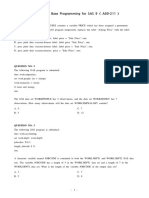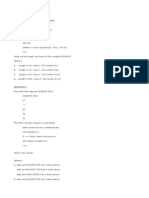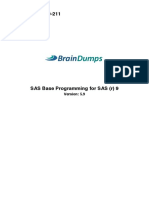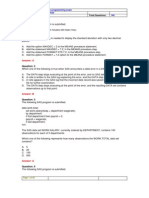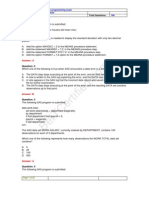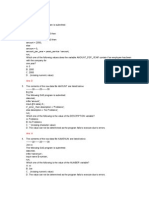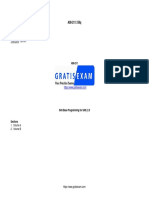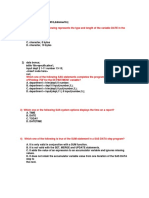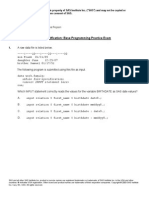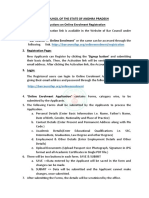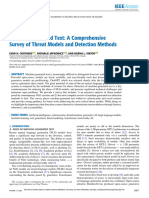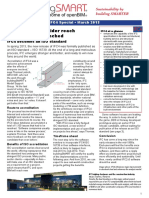World No 1 Cert Exams: SAS Base Programming For SAS (R) 9
Uploaded by
lotus24entWorld No 1 Cert Exams: SAS Base Programming For SAS (R) 9
Uploaded by
lotus24entTestKingonline.
com
No Pass No Pay!
MCSE, CCNA, CCNP, OCP, CIW, JAVA, Sun Solaris, Checkpoint
World No 1 Cert Exams
SAS Base Programming for SAS (r) 9
A00-211
©Copyrights 2005-2006 TestKingonline All Rights Reserved.
Congratulations!
You have purchased a TestKingonline. Study Guide.
This study guide is a complete collection of questions and answers that have been developed by our professional & certified team.
You must study the contents of this guide properly in order to prepare for the actual certification test. The average time that we would
suggest you for studying this study guide is approximately 10 to 20 hours and you will surely pass your exam. We guarantee it!
GOOD LUCK!
DISCLAIMER
This study guide and/or material is not sponsored by, endorsed by or affiliated with Microsoft, Cisco, Oracle, Citrix, CIW,
Checkpoint, Novell, Sun/Solaris, CWNA, LPI, ISC, etc. All trademarks are properties of their respective owners.
Guarantee
If you use this study guide correctly and still fail the exam, send a scanned copy of your official score notice at:
Sales@Testkingonline.com
We will gladly refund the cost of this study guide or give you an exchange of study guide of your choice of the Free.
This material is protected by copyright law and international treaties. Unauthorized reproduction or distribution of this material, or
any portion thereof, may result in severe civil and criminal penalties, and will be prosecuted to the maximum extent possible under
law.
©Copyrights 2005-2006 TestKingonline All Rights Reserved.
Question: 1
The SAS data set SASUSER.HOUSES contains a variable PRICE which has been assigned a
permanent label of “Asking Price”. Which SAS program temporarily replaces the label “Asking
Price” with the label “Sale Price” in the output?
A - proc print data = sasuser.houses; label price = “Sale Price”; run;
B - proc print data = sasuser.houses label; label price “Sale Price”; run;
C - proc print data = sasuser.houses label; label price = “Sale Price”; run;
D - proc print data = sasuser.houses; price = “Sale Price”; run;
Answer: C
Question: 2
The following GAS program is submitted:
data work.empsalary;
set work.people (in = inemp)
work.money (in = insal);
if insal and inemp;
run;
The SAG data set WORKPEOPLE has 5 observations, and the data set WORKMONEY has 7
observations. How many observations will the data set WORK.EMPSALARY contain?
A-0
B-5
C-7
D - 12
Answer: A
Question: 3
The following SAS program is submitted:
data work.accounting;
set work.dept1 work.dept2;
jobcode = ‘FA1’;
length jobcode $ 8;
run;
A character variable named JOBCODE is contained in both the WORK.DEPT1 and
WORK.DEPT2 SAS data sets. The variable JOBCODE has a length of 5 in the WORK.DEPT1
data set and a length of 7 in the WORK.DEPT2 data set. What is the length of the variable
JOBCODE in the output data set?
A-3
B-5
C-7
D-8
Answer: B
Question: 4
Given the SAS data set SASDATA.TWO:
SASDATA.TWO
XY
-- __
52
©Copyrights 2005-2006 TestKingonline All Rights Reserved.
54
36
The following SAS program is submitted:
data sasuser.one one sasdata.three;
set sasdata two;
if x = 5 then output sasuser.one;
else output sasdata three;
run;
What is the result?
A - The data set SASUSER.ONE has 0 observations, the data set ONE has 0 observations, and
the data set SASDATA.THREE has 0 observations.
B - The data set SASUSER.ONE has 2 observations, the data set ONE has 0 observations, and
the data set SASDATA.THREE has 1 observation.
C - The data set SASUSER.ONE has 2 observations, the data set ONE has 3 observations, and
the data set SASDATA.THREE has 1 observation.
D - No data sets are output. The DATA step fails execution due to errors.
Answer: B
Question: 5
The following SAS program is submitted:
footnote 1 ‘Sales Report for Last Month’;
footnote2 ‘Selected Products Only’;
footnote3 ‘All Regions’;
footnote4 ‘All Figures in Thousands of Dollars’;
proc print data = sasuser.shoes;
footnote2 ‘All Products’;
run;
Which footnote(s) is/are displayed in the report?
A - All Products
B - Sales Report for Last Month All Products
C - All Products All Regions All Figures in Thousands of Dollars
D - Sales Report for Last Month All Products All Regions All Figures in Thousands of Dollars
Answer: B
Question: 6
Given the raw data record DEPT:
----|----10---|----20---|----30
Printing 750
The following SAS program is submitted:
data bonus;
infile ‘dept’;
inputdept$ 1-11 number 13- 15;
<insert statement here>
run;
Which SAS statement completes the program and results in a value of ‘Printing750’ for the
DEPARTMENT variable?
A - department = dept II number;
B - department = left(dept) II number;
C - department = trim(dept) number;
D - department = trim(dept) put(number,3.);
©Copyrights 2005-2006 TestKingonline All Rights Reserved.
Answer: D
Question: 7
The following SAS program is submitted:
data one;
addressl = ‘214 London Way’;
run;
data one;
set one;
address = tranwrd(address1, ‘Way’, ‘Drive’); run;
What are the length and value of the variable ADDRESS?
A - Length is 14; value is ‘214 London Dri’.
B - Length is 14; value is ‘214 London Way’.
C - Length is 16; value is ‘214 London Drive’.
D - Length is 200; value is ‘214 London Drive’.
Answer: D
Question: 8
The following SAS program is submitted:
data work.sets;
do until (prod gt 6);
prod + 1;
end;
run;
What is the value of the variable PROD in the output data set?
A-6
B-7
C-8
D - (missing numeric)
Answer: B
Question: 9
Given the SAS data sets EMPLOYEE and SALARY:
EMPLOYEE SALARY
Fname age name salary
Bruce 30 Bruce 25000
Dan 40 Bruce 35000
Dan 25000
The following SAS program is submitted:
data work.empdata;
<insert MERGE statement here>
by fname;
totsal + salary;
run;
Which MERGE statement correctly completes the program?
A - merge employee
salary rename = fname = name;
B - merge employee
salary rename(name = fname);
C - merge employee
salary (rename = (fname = name));
©Copyrights 2005-2006 TestKingonline All Rights Reserved.
D - merge employee
salary (rename = (name = fname));
Answer: D
Question: 10
Which program displays a listing of all data sets in the SASUSER library?
A - proc contents lib = sasuser.all; run;
B - proc contents data = sasuser.all; run;
C - proc contents lib = sasuser._alI_; run;
D - proc contents data = sasuser._all_; run;
Answer: D
Question: 11
The following SAS program is submitted:
proc sort data = work.employee;
by descending fname;
proc sort data = work.salary;
by descending fname;
data work.empdata;
merge work.employee
work.salary;
by fname;
run;
Why does the program rail to execute?
A - The SORT procedures contain invalid syntax.
B - The merged data sets are not permanent SAS data sets.
C - The RUN statement was omitted alter each or the SORT procedures.
D - The data sets were not merged in the order by which they were sorted.
Answer: D
Question: 12
The following SAS program Is submittad:
data work.sales;
do year = 1 to 5;
do month=1 to 12;
x+1;
output
end;
end;
run;
How many observations are written the WORK SALES data set?
A-0
B-1
C-5
D - 60
Answer: D
Question: 13
©Copyrights 2005-2006 TestKingonline All Rights Reserved.
Given the following raw data record:
----I----10---I----20---I----30
son Travis,
The following output is desired:
Obs relation firstname
1 son Travis
Which SAS program correctly reads in the raw data?
A - data family ( dIm = ‘,’); infile ‘tile specification’; input relation $ firstname $; run;
B - options dIm = ‘,’; data family; infile ‘file specification’; input relation $ firstname $; run;
C - data family; infile ‘file specification’ dIm = ‘,’; input relation $ firstname $; run;
D - data family; infile ‘file specification’; input relation $ firstname $ / dim = ‘,’; run;
Answer: C
Question: 14
Given the SAS data set AGES:
AGES
AGE
---------
The variable AGE contains character values. The following SAS program is submitted:
data subset;
set ages;
where age> 12;
run;
How many observations are written out to the data set SUBSET?
A-0
B-1
C-2
D-3
Answer: A
Question: 15
Given the SAS data set PRICES:
PRICES
prodid price producttype sales returns
K12S 5.10 NETWORK 15 2
B132S 2.34 HARDWARE 300 10
R18KY21.29 SOFTWARE 25 5
3KL8BY 6.37 HARDWARE 125 15
DY65DW 5.60 HARDWARE 45 5
DGTY23 4.55 HARDWARE 67 2
The following SAS program is submitted:
data hware inter soft;
set prices (keep = producttype price);
if price le 5.00;
if producttype = ‘HARDWARE’ then output HWARE;
else if producttype = ‘NETWORK’ then output INTER;
else if producttype = ‘SOFTWARE’ then output SOFT;
run;
How many observations does the HWARE data set contain?
A-0
B-2
©Copyrights 2005-2006 TestKingonline All Rights Reserved.
C-3
D-4
Answer: B
Question: 16
The following SAS program is submitted:
data work.accounting;
set work.department;
length jobcode $ 12;
jobcode=’FAl’;
run;
The WORK.DEPARTMENT data set contains a character variable named JOBCODE with a
length of 5.
What is the result?
A - The length of the variable JOBCODE is 3.
B - The length of the variable JOBCODE is 5.
C - The length of the variable JOSBODE is 12.
D - The program fails to execute due to errors.
Answer: B
Question: 17
Which ODS statement option terminates output being written to an HTML rile?
A - END
B - QUIT
C - STOP
D - CLOSE
Answer: D
Question: 18
The SAS data set PETS is sorted by the variables TYPE and BREED.
The following SAS program is submitted:
proc print data = pets;
var type breed;
sum number;
run;
What is the result?
A - The SUM statement produces only a grand total of NUMBER.
B - The SUM statement produces only subtotals of NUMBER for each value of TYPE.
C - The SUM statement produces both a grand total of NUMBER and subtotals of NUMBER for
each value of TYPE.
D - Nothing is produced by the SUM statement; the program fails to execute.
Answer: A
Question: 19
The following SAS program is submitted:
data work.passengers;
if OrigPassengers = then
OrigPassengers = 100;
©Copyrights 2005-2006 TestKingonline All Rights Reserved.
TransPassengers = 100;
OrigPassengers =
TotalPassengers = sum (OrigPassengers, TransPassengers) +0;
run;
What is the value of the TOTALPASSENGERS variable in the output data set?
A-0
B - 100
C - 200
D - (missing numeric value)
Answer: B
Question: 20
Given the SAS data set PRICES:
PRICES
Prodid price producttype sales returns
K125 5.10 NETWORK 15 2
B132S 2.34 HARDWARE 300 10
R18KY2 1.29 SOFTWARE 25 5
3KL8BY 6.37 HARDWARE 125 15
DY65DW 5.60 HARDWARE 45 5
DGTY23 4.55 HARDWARE 67 2
The following SAS program is submitted:
data hware inter cheap;
set prices(keep = productype price);
if producttype = ‘HARDWARE’ then output hware; else if producttype = ‘NETWORK’ then output
inter; if price le 5.00;
run;
How many observations does the HWARE data set contain?
A-0
B-2
C-3
D-4
Answer: D
Question: 21
The following SAS program is submitted:
data work.sales;
do year = 1 to 5;
do month = 1 to 12;
x+ 1;
end;
end;
run;
How many observations are written to the WORK.SALES data set?
A-0
B-1
C-5
D - 60
Answer: B
©Copyrights 2005-2006 TestKingonline All Rights Reserved.
Question: 22
The following SAS program is submitted:
data work.totalsales (keep = monthsales{12});
set work.monthlysales (keep = year product sales);
array monthsales{12);
do i = 1 to 12; monthsales{i) = sales;
end;
run;
The program fails execution due to syntax errors. What is the cause of the syntax error?
A - The variable MONTHSALES does not exist.
B - An array cannot be referenced on a KEEP data set option.
C - The KEEP= data set option should be (KEEP = MONTHSALES).
D - The KEEP= data set option should be the statement KEEP MONTHSALES{12}.
Answer: B
Question: 23
Given the SAS data set EMPLOYEES:
EMPLOYEES
NAME SALARY
-------- ------------
Innis 60000
Jolli 50000
Ellis 55000
Liu 45000
The following SAS program is submitted:
proc print data = employees; where name like ‘_i%’;
run;
What is contained in the output?
A - Liu only
B - Innis and Ellis only
C - Innis, Ellis, and Liu only
D - Innis, Jolli, Ellis, and Liu
Answer: A
Question: 24
Given the SAS data set ONE:
ONE
Obs Dte
----- --------
1 09JAN2005
2 12JAN2005
The following SAS program is submitted:
data two;
set one;
day = <insert expression here>;
format dte date9.;
run;
The data set TWO is created:
TWO
Obs Dte Day
1 09JAN2005 1
12 JAN2005 4
©Copyrights 2005-2006 TestKingonline All Rights Reserved.
Which expression successfully completed the program and created the variable DAY?
A - day(dte)
B - weekday(dte)
C - dayofweek(dte)
D - datdif(dte,’01jan2005’d,’act/act’)
Answer: B
Question: 25
Read the table:
Given the SAS data set SASUSER.HOUSES:
Obs style bedrooms baths price sqteet street
1 CONDO 2 1.5 80050 1200 MAIN
2 CONDO 3 2.5 79350 1300 ELM
3 CONDO 4 2.5 127150 1400 OAK
4 CONDO 2 2.0 110700 1100 FIFTH
5 TWOSTORY 4 3.0 107250 2100 SECOND
6 TWOSTORY 2 1.0 55650 1600 WEST
7 TWOSTORY 2 1.0 69250 1450 NORTH
6 TWOSTORY 4 2.5 102950 2000 SOUTH
The following SAS program is submitted:
proc report data = sasuser.houses nowd headline;
column style price;
where price It 100000;
<insert DEFINE statement here>
define price / mean width = 9 format = dollar12.;
title;
run;
The following output is desired:
style price
------- ------
CONDO $79,700
TWOSTORY $62550
Which DEFINE statement completes the program and produces the desired output?
A - define style / width = 9,
B - define style / orderwidth = 9;
C - define style / group width = 9;
D - define style / display width = 9;
Answer: C
Question: 26
Given the SAS data set WORKAWARDS:
WORK.AWARDS
FNAME POINTS MONTH
----------- ------------ -----------
Amy 2 4
Amy 1 7
Gerard 3 3
Wang 3 3
Wang 1 12
Wang 1 8
The following SAS program is submitted:
proc sort data = work.awards;
©Copyrights 2005-2006 TestKingonline All Rights Reserved.
by descending fname points;
run;
How are the observations sorted?
A - ENAME POINTS MONTH
Wang 3 3
Wang 1 12
Wang 1 8
Gerard 3 3
Amy 2 4
Amy 1 7
B - ENAME POINTS MONTH
Amy 2 4
Amy 1 7
Gerard 3 3
Wang 3 3
Wang 1 8
Wang 1 12
C - ENAME POINTS MONTH
Wang 3 3
Wang 1 8
Wang 1 12
Gerard 3 3
Amy 2 4
Amy 1 7
D - ENAME POINTS MONTH
Wang 1 12
Wang 1 8
Wang 3 3
Gerard 3 3
Amy 1 7
Amy 2 4
Answer: D
Question: 27
The following SAS program is submitted:
libname temp ‘SAS data library’;
data work.new;
set temp.jobs;
format newdate mmddw10.;
mdate = month(newdate);
ddate = weekday(newdate);
run;
proc print data = work.new; run;
The variable NEWDATE contains the SAS date value for April 15. 2005. What output is produced
if April 15, 2005 falls on a Friday?
A - Obsnewdate mdate ddate
104/15/2005 APR 6
B - Obs newdate mdate ddate
104/15/2005 4 6
C - Obs newdate mdate ddate
104/15/2005 APR 7
D - Obs newdate mdate ddate
104/15/2005 4 7
©Copyrights 2005-2006 TestKingonline All Rights Reserved.
Answer: B
Question: 28
Given the contents of the raw data file PRODUCT:
----I----10---I----20---I----30
24613 $25.31
The following SAS program is submitted:
data inventory;
infile ‘product’;
input idnum 5. @10 price;
run;
What is the value of the PRICE variable?
A - 25.31
B - $25.31
C - . (missing numeric value)
D - No value is stored.
Answer: C
Question: 29
The following SAS program is submitted:
proc contents data = sashelp.class varnum; quit;
What does the VARNUM option print?
A - a list of variable names
B - the total number of variables
C - a list of the variables in alphabetic order
D - a list of the variables in the order they were created
Answer: D
Question: 30
The following SAS program is submitted:
data test;
set chemists;
itjobcode = ‘Chem2’
then description = ‘Senior Chemist’;
else description = ‘Unknown’;
run;
The value for the variable JOBCODE is:
JOBCODE
-------------
chem2
What is the value of the variable DESCRIPTION?
A - chem2
B - Unknown
C - Senior Chemist
D - ‘ ‘ (missing character value)
Answer: B
Question: 31
Given the AIRPLANES data set
©Copyrights 2005-2006 TestKingonline All Rights Reserved.
AlRPLANES
TYPE MPG
-------- ------
F-18 105
C-130 25
Harrier 75
A-6 110
The following SAS program is submitted:
data gt100;
set airplanes(keep = type mpg load);
load = mpg * 150;
run;
The program fails to execute due to syntax errors.
What is the cause of the syntax error?
A - MPG is not a numeric variable.
B - LOAD is not a variable in the data set GT100.
C - LOAD is not variable in the data set AIRPLANES.
D - LOAD must be defined prior to the SET statement.
Answer: C
Question: 32
Given the raw data file EMPLOYEE:
----I----1 0---I----20---I----30
Ruth 39 11
Jose 32 22
Sue 30 33
John 40 44
The following SAS program is submitted:
data test;
infile ‘employee’;
input employee_name $ 1-4;
if employee_name = ‘Ruth’ then input idnum 10-11;
else input age 7-8;
run;
What value does the variable IDNUM contain when the name of the employee is “Ruth”?
A - 11
B - 22
C - 33
D - (missing numeric value)
Answer: B
Question: 33
The following SAS program is submitted:
data temp.x;
set sasuser.y;
run;
What must be submitted prior to this SAS program for the program to execute successfully?
A - A LIBNAME statement for the libref TEMP only must be submitted.
B - A LIBNAME statement for the libref SASUSER only must be submitted.
C - LIBNAME statements for the librefs TEMP and SASUSER must be submitted.
D - No LIBNAME statement needs to be submitted.
©Copyrights 2005-2006 TestKingonline All Rights Reserved.
Answer: A
Question: 34
The data set RALESTATE has the variable LOCALFEE with a format or 9. and a variable
COUNTRYFEE with a format or 7.;
The following SAS program is submitted:
data history;
format local fee country fee percent6.;
set realestate;
local fee = local fee / 100;
country fee = country fee / 100;
run;
What are the formats of the variables LOCALFEE and COUNTRYFEE in the output dataset?
A - LOCALFEE has format of 9. and COUNTRYFEE has a format of 7.
B - LOCALFEE has format of 9. and COUNTRYFEE has a format of percent6.
C - LOCALFEE has format of percent6. and COUNTRYFEE has a format of percent6.
D - The data step fails execution; there is no format for LOCALFEE
Answer: C
Question: 35
The following SAS program is submitted:
proc freq data = class;
tables gender * age / <insert option here>;
run;
The following report is created:
The FREQ Procedure
Table of gender by age
Row Column
Gender age Frequency Percent Percent Percent
F 11 1 10.00 20.00 50.00
12 2 20.00 40.00 40.00
13 2 20.00 40.00 66.67
Total 5 50.00 100.00
M 11 1 10.00 20.00 50.00
12 3 30.00 60.00 60,00
13 1 10.00 20.00 33.33
Total 5 50.00 100.00
----------------------------------------------------------------------------------
Total 11 2 20.00 100.00
12 5 50.00 100.00
13 3 30.00 100.00
Total 10 100.00
Which option correctly completes the program and creates the report?
A - LIST
B - NOCOLS
C - CROSSLIST
D - NOCROSSTAB
Answer: C
Question: 36
The value 110700 is stored in a numeric variable named SALARY.
Which FORMAT statement displays the value as $110,700.00 in a report?
©Copyrights 2005-2006 TestKingonline All Rights Reserved.
A - format salary comma11.2;
B - format salary dollar8.2;
C - format salary dollar11.2;
D - format salary comma8.2 dollar8.2;
Answer: C
Question: 37
Given the raw data file YEARAMT:
----|---10---|---20---|----30
1901 2
1905 1
1910 6
1925 .
1941 1
The following SAS program is submitted:
data coins;
infile ‘yearamt’;
input year quantity;
<insert statement(s) here>
run;
Which statement(s) completed the program and produced a non-missing value for the variable
TOTQUANTITY in the final observation of the output data set?
A - totquantity + quantity;
B - totquantity = sum(totquantity + quantity);
C - retain totquantity; totquantity = totquantity + quantity;
D - retain totquantity0; totquantity = totquantity + quantity;
Answer: A
Question: 38
Given the SAS data set EMPLOYEE INFO:
EMPLOYEE_INFO
IDNumber Expenses
2542 100.00
3612 133.15
2198 234.34
2198 111.12
The following SAS program is submitted:
proc sort data = employee_info;
<insert BY statement here>
run;
Which BY statement completes the program and sorts the data sequentially by ascending
expense values within each ascending IDNUMBER value?
A - by Expenses IDNumber;
B - by IDNumber Expenses;
C - by ascending Expenses IDNumber;
D - by ascending IDNumber ascending Expenses;
Answer: B
Question: 39
The following SAS program is submitted:
proc format
©Copyrights 2005-2006 TestKingonline All Rights Reserved.
value score 1 - 50 = ‘Fail’
51 - 100 = ‘Pass’;
run;
proc report data = work.courses nowd;
column exam;
define exam / display format = score.;
run;
The variable EXAM has a value of 50.5.
How will the EXAM variable value be displayed in the REPORT procedure output?
A - Fail
B - Pass
C - 50.5
D - . (missing numeric value)
Answer: C
Question: 40
What is the purpose or the MISSOVER option on the INFILE statement?
A - It prevents SAS from loading a new record when the end of the current record is reached.
B - It enables SAS to scan the input data records until the character string that is specified in the
@‘character-string’ expression is round.
C - It enables SAS to continue to read the next input data record if it does not find values in the
current input tine for all the variables in the statement.
D - It causes the DATA step to stop processing if an INPUT statement reaches the end of the
current record without finding values for all variables in the statement.
Answer: A
Question: 41
The following SAS program is submitted:
data work.test;
set work.staff (keep = jansales febsales marsales);
array diff_sales{3} difsales1 - difsales3;
array monthly{3} jansales febsales marsales;
run;
What new variables are created?
A - JANSALES, FEBSALES and MARSALES
B - MONTHLY1, MONTHLY2 and MONTHLY3
C - DIFSALES1, DIFSALES2 and DIFSALES3
D - DIFF_SALES1, DIFF_SALES2 and DIFF_SALES3
Answer: C
Question: 42
What describes the SAS automatic _ERRDR_ variable?
A - The _ERROR_ variable contains the values ‘TRUE’ or ‘FALSE.’
B - The _ERROR variable maintains a count of the number of data errors.
C - The _ERROR_ variable can be used in expressions or calculations in the DATA step.
D - The ERROR_variable contains the number or the observation that caused the error.
Answer: C
©Copyrights 2005-2006 TestKingonline All Rights Reserved.
Question: 43
Given the following raw data record:
07Jan20 05
Which INFOFRMAT reads this raw data and stores it as a SAS date value?
A - dmy9.
B - date9.
C - ddMMMyy9.
D - ddmmmyyyy9.
Answer: B
Question: 44
Which statement correctly computes the average of four numerical values?
A - average = mean(num1, num4);
B - average = mean(num1 - num4);
C - average = mean(ofnum1 - num4)
D - average = mean(num1 num2 num3 num4);
Answer: C
Question: 45
The following SAS program is submitted:
libname temp ‘SAS data library’;
data temp.sales;
merge temp sales
work.receipt;
by names;
run;
The input data files are sorted by the NAMES variable:
What is the result?
A - The program executes successfully and a temporary SAS data set is created.
B - The program executes successfully and a permanent SAS data set is created.
C - The program fails execution because the same SAS data set is referenced for both read and
write operations.
D - The program fails execution because the SAS data sets on the MERGE statement are in two
different libraries.
Answer: B
Question: 46
Given the contents of the raw data file TYPECOLOR:
----I----10---I----20---I----30
Daisyyellow
The following SAG program is submitted:
data flowers;
infile ‘typecolor’;
input type$ 1-5+1 color$;
run;
What are the values of the variables TYPE and COLOR?
A - type color
daisyyellow
©Copyrights 2005-2006 TestKingonline All Rights Reserved.
B - type color
daisyyellow
C - type color
daisyyellow” “(missing character value)
D - No values are stored for the TYPE and COLOR variables.
Answer: B
Question: 47
A user-defined format has been created using the FORMAT procedure. Where is it stored?
A - in a SAS catalog
B - in an external binary file
C - in a SAS dataset in the WORK library
D - in a SAS dataset in a permanent SAS data library
Answer: A
Question: 48
The following SAS program is submitted:
data work.flights;
destination = ‘cph’;
select(destination);
when(’LHR’) city = ‘London’;
when(’CPH’) city = ‘Copenhagen’;
otherwise city = ‘Other’;
end;
run;
What is the value of the CITY variable?
A - Other
B - Copenh
C - Copenhagen
D - ‘‘(missing character value)
Answer: A
Question: 49
The following SAS program is submitted:
data work.new;
length word $7;
amount = 4;
it amount = 4 then word = ‘FOUR’;
else if amount = 7
then word = ‘SEVEN’;
else word = ‘NONE!!!’;
amount = 7;
run;
What are the values of the AMOUNT and WORD variables in SAS dataset work.new?
A - amount word
4 FOUR
B - amount word
4 NONE!!!
C - amount word
©Copyrights 2005-2006 TestKingonline All Rights Reserved.
7 FOUR
D - amount word
7 SEVEN
Answer: C
Question: 50
The following SAS program is submitted, creating the SAS data set ONE:
data one;
infile ‘file specification’;
input num chars$;
run;
ONE
NUM CHAR
------- ---------
1 23
3 23
1 77
The following SAS program is submitted:
proc print data = one;
where char = 23;
run;
What is output?
A - NUM CHAR
1 77
2
B - NUM CHAR
1 23
3 23
C - NUM CHAR
1 23
3 23
1 77
D - No output is generated.
Answer: D
Question: 51
The following SAS program is submitted:
data work.retail;
cost = ‘20000’;
total= .10* cost
run;
What is the result?
A - The value of the variable TOTAL in the output data set is 2000. No messages are written to
the SAS log.
B - The value of the variable TOTAL in the output data set is 2000. A note that conversion has
taken place is written to the SAS log.
C - The value of the variable TOTAL in the output data set is missing. An error message is written
to the SAS log.
D - The variable TOTAL in the output data set has no value. The program fails to execute due to
a syntax error.
Answer: B
©Copyrights 2005-2006 TestKingonline All Rights Reserved.
Question: 52
The following SAS program is submitted:
Data_null_;
set old;
put sales 1 sales2;
run;
Where is the output written?
A - to the SAS log
B - to the SAS data set _NULL_
C - to the SAS output window or to an output file
D - to the raw data file that was most recently opened
Answer: A
Question: 53
The following SAS program is submitted:
data work.test;
array items{3} _temporary_;
run;
What are the names of the variable(s) in the WORKTEST data set?
A - ITEMS
B - ITEMS1, ITEMS2, ITEMS3
C - No variables are created because it is a temporary array.
D - The program fails to execute because there are no variables listed on the ARRAY statement.
Answer: C
Question: 54
Read the table
The following SAS program is submitted:
proc freq data = sales;
<insert TABLES statement here>
run;
The following output is created by the FREQUENCY procedure:
The FREQ Procedure
Table of region by product
region product
Frequency
Percent
Row Pct
Col Pct corn cotton oranges Total
EAST 2 1 1 4
22.22 11.11 11.11 44.44
50.00 25.00 25.00
50.00 33.33 50.00
SOUTH 2 2 1 5
22.22 22.22 11.11 55.56
40.00 40.00 20.00
50.00 66.67 50.00
Total 4 3 2 9
4444 33.33 22.22 100.00
Which TABLES statement(s) completed the program and produced the output?
A - tables region product;
©Copyrights 2005-2006 TestKingonline All Rights Reserved.
B - tables region * product;
C - tables product * region;
D - tables product; tables region;
Answer: B
Question: 55
The following SAS program is submitted:
data one;
date = ‘04juI2005’d;
format date weekdate.; run;
proc print data = one; run;
What output is generated?
A - Obs date
1 Monday, July 4, 2005
B - Obs date
1 July4, 2005
C - Obs date
1 04Jul2005
D - Obs date
1 Monday, 07/04/2005
Answer: A
Question: 56
The following SAS program is submitted:
data test;
set sasuser.employees;
if 2 le years_service le 10 then
amount = 1000;
else amount = 0;
amount_per_year = years_service / amount
run;
What is the value of the variable AMOUNT_PER_YEAR if an employee has been with the
company for one year?
A-0
B - 0.001
C-1
D - . (missing numeric value)
Answer: D
Question: 57
Given the SAS data set PERM.STUDENTS:
PERM.STUDENTS
NAME AGE
--------- -------
Alfred 14
Alice 13
Barbara 13
Carol 14
The following SAS program is submitted:
libname perm ‘SAS data library’;
data students;
©Copyrights 2005-2006 TestKingonline All Rights Reserved.
set perm.students;
file ‘file specification’;
put name $ age;
<insert statement here>
run;
The following double-spaced file is desired as output
Alfred 14
Alice 13
Barbara 13
Carol 14
Which statement completes the program and creates the desired file?
A - put
B - put/;
C - double;
D - put _null_;
Answer: A
Question: 58
The following SAS program is submitted:
data work.total;
set work.salary(keep = department wagerate);
by department;
if first.department
then payroll = 0;
payroll + wagerate;
if last.department;
run;
The SAS data set named WORKSALARY contains 10 observations for each department, and is
currently ordered by DEPARTMENT.
Which statement is true?
A - The BY statement in the DATA step causes a syntax error.
B - The statement payroll + wagerate; in the DATA step causes a syntax error.
C - The values of the variable PAYROLL represent the total for each department in the
WORK.SALARY data set.
D - The values of the variable PAYROLL represent a total for all values of WAGERATE in the
WORKSALARY data set.
Answer: C
Question: 59
Given the contents of the raw data file EMPLOYEE:
----|----10----|----20----|----30
Alan 19/2/2004 ACCT
Rob 22/5/2004 MKTG
MaryJane 14/3/2004 EDUC
The following SAS program is submitted:
data emps;
infile ‘employee’;
input@1 name$
@15 date <insert INFORMAT here>
@25 department$;
run;
Which INFORMAT correctly completes the program?
©Copyrights 2005-2006 TestKingonline All Rights Reserved.
A - date9.
B - ddmmyyyy9.
C - ddmmyy10.
D - ddmmyyyy10.
Answer: C
Question: 60
The following SAS program is submitted:
data test;
infile ‘file specification’;
input name $ amount@@;
run;
Which of the following is true?
A - Two @@ together are the same as one c.
B - Two @@ hold the data records until the bottom of the DATA step.
C - Two @@ hold the raw data record across iterations of the DATA step.
D - Two @@ are invalid syntax and will cause the program to fail to execute.
Answer: C
Question: 61
Given the SAS data set QTR 1_REVENUE:
destination revenue
YYZ 53634
FRA 62129
FRA 75962
RDU 76254
YYZ 82174
The following SAS program is submitted:
proc sort data = qtr1_revenue;
by destination descending revenue; run;
What is the first observation in the output data set?
A - destination revenue
FRA 62129
B - destination revenue
FRA 75962
C - destination revenue
YYZ 53634
D - destination revenue
YYZ 82174
Answer: B
Question: 62
The following SAS program is submitted:
data numrecords;
infile ‘file specification’;
input@1 patient $15.
relative$ 16-26@;
if relative = ‘children’ then
input @54 diagnosis $15. @;
else if relative = ‘parents’ then
input @28 doctor $15.
©Copyrights 2005-2006 TestKingonline All Rights Reserved.
clinic $ 44-53
@54 diagnosis $15. @;
input age;
run;
How many raw data records are read during each iteration of the DATA step execution?
A-1
B-2
C-3
D-4
Answer: A
Question: 63
Given the SAS data set ONE:
ONE
XYZ
--- --- ---
1 A 27
1 A 33
1 B 45
2 A 52
2 B 69
3 B 70
4 A 62
4 C 91
The following SAS program is submitted:
data two;
set one;
by x y;
if first.y;
run;
proc print data = two noobs;
run;
4Which report is produced?
A-XYZ
1 A 27
1 B 45
2 A 52
2 B 69
3 B 70
4 A 82
4 C 91
B-XYZ
1 A 33
1 B 45
2 A 52
2 B 69
3 B 70
4 A 82
4 C 91
C-XYZ
1 B 45
2 A 52
2 B 69
©Copyrights 2005-2006 TestKingonline All Rights Reserved.
3 B 70
4 A 82
4 C 91
D - The PRINT procedure tails because the data set TWO is not created in the DATA step.
Answer: A
Question: 64
After a SAS program is submitted, the following is written to the SAS log:
105 data january;
106 set allmonths(keep = product month num_sold cost);
107 if month = ‘Jan’ then output january;
108 sales = cost * num_sold;
109 keep = product sales;
------
22
ERROR 22-322: Syntax error, expecting one of the following:!,
!!, &, *,**, +, -,/, <,< =, <>, =, >, ><, >=,
AND, EQ, GE, GT, IN, LE, LT, MAX, MIN, NE, NG, NL,
NOTIN, OR,^=,|,II,
110 run;
What changes should be made to the KEEP statement to correct the errors in the LOG?
A - keep product sales;
B - keep product, sales;
C - keep = product, sales;
D - keep = (product sales);
Answer: A
Question: 65
The following SAS program is submitted:
data combine;
prefix=’505’;
middle=’6465 ‘;
end=’09090’;
<insert statement here>;
run;
Which statement successfully completes the program so that TOTAL has a value of 505-6465-
09090?
A - total = cat(’-’, prefix, middle, end);
B - total = catx(’-’, prefix, middle, end);
C - total = prefix !!’-’!! middle ‘‘!!’-’!! end;
D - total = prefix!!’-’!! left(middle)!!’-’!! end;
Answer: B
Question: 66
The following SAS program is submitted:
<insert ODS statement here>
proc means data = sasuser.shoes;
where product in (‘Sandal’ , ‘Slipper’ , ‘Boot’);
run;
<insert ODS statement here>
Which ODS statements complete the program and send the report to an HTML file?
©Copyrights 2005-2006 TestKingonline All Rights Reserved.
A - ods html = ‘sales.html’; ods html close;
B - ods file = ‘sales.html’; ods file close;
C - ods file html = ‘sales.html’; ods file close;
D - ods html file = ‘sales.html’; ods html close;
Answer: D
Question: 67
Given the raw data file AMOUNT:
----I---- 10---I----20---I----30
$1,234
The following SAS program is submitted:
data test;
infile ‘amount’;
input@1 salary 6.;
if_error_then description = ‘Problems’;
else description = ‘No Problems’;
run;
What is the result?
A - The value of the DESCRIPTION variable is No Probl.
B - The value of the DESCRIPTION variable is Problems.
C - The value of the DESCRIPTION variable is No Problems.
D - The value of the DESCRIPTION variable can not be determined.
Answer: B
Question: 68
Given the SAS data set PEPM.STUDENTS:
PERM.STUDENTS
NAME AGE
--------- ------
Alfred 14
Alice 13
Barbara 13
Carol 14
The following SAS program is submitted:
libname perm ‘SAS data library’;
data students;
set perm.students;
file ‘file specification’;
put name $15. @5 age 2.;
run;
What is written to the output raw data file?
A - ----I----10---I----20---I----30
Alfred 14
Alice 13
Barbara 13
Carol 14
B - ----I----10---I----20---I----30
Alfr14
Alic13
Barb13a
Carol 4
C - ----I----10---I----20---I----30
©Copyrights 2005-2006 TestKingonline All Rights Reserved.
Alfr14ed
Alic130
Barb13ara
Caro141
D - ----I----10---I----20---I----30
Alfred14
Alice13
Barbara13
Carol14
Answer: B
Question: 69
The following SAS program is submitted:
data work.total;
set work.salary(keep = department wagerate);
by department;
if first.department
then payroll = 0;
payroll + wagerate;
if last.department
run;
The SAS data set WORK.SALARY, currently ordered by DEPARTMENT, contains 100
observations for each of 5 departments.
What is the result?
A - The WORK.TOTAL data set contains 5 observations.
B - The WORKTDTAL data set contains 100 observations.
C - The WORKTOTAL data set contains 500 observations.
D - The program fails to execute due to errors.
Answer: A
Question: 70
The following SAS program is submitted;
data combine;
country = ‘Italy, Russia, ireland’;
found = find(country, ‘i’);
run;
What is the value of the variable FOUND in the output data set?
A-1
B - 12
C - Italy
D - Russia
Answer: B
©Copyrights 2005-2006 TestKingonline All Rights Reserved.
You might also like
- SAS Base Programming Exam For SAS 9 70 Q&ANo ratings yetSAS Base Programming Exam For SAS 9 70 Q&A43 pages
- SAS Base Programming For SAS 9 Exam - More Samples Q&ANo ratings yetSAS Base Programming For SAS 9 Exam - More Samples Q&A5 pages
- BeITCertified SAS Institute A00-211 Free Questions DumpsNo ratings yetBeITCertified SAS Institute A00-211 Free Questions Dumps20 pages
- SAS Programming Quiz: Questions & OptionsNo ratings yetSAS Programming Quiz: Questions & Options11 pages
- SAS Institute - A00-211 SAS Base Programming For SAS (R) 9No ratings yetSAS Institute - A00-211 SAS Base Programming For SAS (R) 95 pages
- SAS Interview Q&A for Pharma Professionals100% (1)SAS Interview Q&A for Pharma Professionals50 pages
- SAS Certified Base Programmer For SAS 9 - A00-211 - Dumps75% (36)SAS Certified Base Programmer For SAS 9 - A00-211 - Dumps30 pages
- SAS Institute A00-211 PDF Exam Questions and Answers From Testking100% (3)SAS Institute A00-211 PDF Exam Questions and Answers From Testking10 pages
- Be It Certified SAS Institute A00-201 Free Questions DumpsNo ratings yetBe It Certified SAS Institute A00-201 Free Questions Dumps10 pages
- Q1. The Following SAS Program Is SubmittedNo ratings yetQ1. The Following SAS Program Is Submitted23 pages
- SAS Certification Practice Exam - Base Programming100% (1)SAS Certification Practice Exam - Base Programming18 pages
- Looking For Real Exam Questions For IT Certification Exams!100% (3)Looking For Real Exam Questions For IT Certification Exams!57 pages
- SAS Institute A00-211: Exam Name: SAS Base Programming For SAS 9 Q & A: 140 Q&AsNo ratings yetSAS Institute A00-211: Exam Name: SAS Base Programming For SAS 9 Q & A: 140 Q&As6 pages
- SAS-Institute Test4prep A00-211 v2019-06-18 by Abrielle 159qNo ratings yetSAS-Institute Test4prep A00-211 v2019-06-18 by Abrielle 159q118 pages
- Debugging M464 and R8 Errors in TetraMAXNo ratings yetDebugging M464 and R8 Errors in TetraMAX5 pages
- CPSC 1105 Assignment 2 Template 1 - 1687663454447No ratings yetCPSC 1105 Assignment 2 Template 1 - 16876634544472 pages
- HP Probook 650 G8 Notebook PC: Modern Design For The EnterpriseNo ratings yetHP Probook 650 G8 Notebook PC: Modern Design For The Enterprise4 pages
- Bar Council of The State of Andhra Pradesh Instructions On Online Enrolment RegistrationNo ratings yetBar Council of The State of Andhra Pradesh Instructions On Online Enrolment Registration3 pages
- Case Study - Dynamics CRM - Public SectorNo ratings yetCase Study - Dynamics CRM - Public Sector4 pages
- MAPDL-Intro - 13.0 - WS06-geometry ImportNo ratings yetMAPDL-Intro - 13.0 - WS06-geometry Import22 pages
- EPA 2006 Architecture Standard and GuidanceNo ratings yetEPA 2006 Architecture Standard and Guidance41 pages
- 90204-1023DEJ E Series External Lo Manual PDFNo ratings yet90204-1023DEJ E Series External Lo Manual PDF92 pages
- If You Are Not Connected To The VINCI Energies Network (Outside The Business Unit's Premises)No ratings yetIf You Are Not Connected To The VINCI Energies Network (Outside The Business Unit's Premises)16 pages
- 2023 IEEE Machine-Generated - Text - A - Comprehensive - Survey - of - Threat - Models - and - Detection - MethodsNo ratings yet2023 IEEE Machine-Generated - Text - A - Comprehensive - Survey - of - Threat - Models - and - Detection - Methods26 pages
- Powertech Controller - SC503 - Datasheet - V1.0 - 210716No ratings yetPowertech Controller - SC503 - Datasheet - V1.0 - 2107162 pages
- International Home of Openbim: Ifc4 Poised For Wider Reach As Iso 16739 LaunchedNo ratings yetInternational Home of Openbim: Ifc4 Poised For Wider Reach As Iso 16739 Launched4 pages


